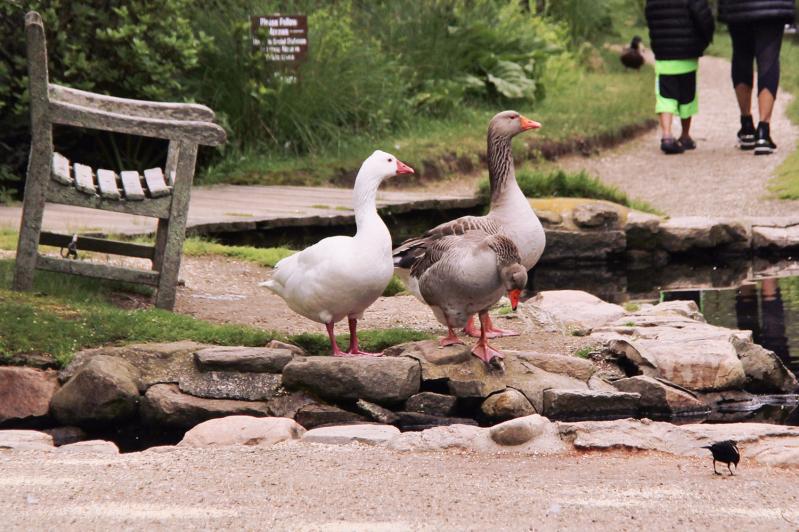Meghan Bambrick was enjoying a walk on the East Hampton Village Nature Trail last week when she saw something out of the ordinary.
“I noticed a black box sitting on its side with a soda can crushed inside its hole,” she said. After crossing over Huntting Lane and nearing Fithian Lane, “I noticed a fake rock. Next to that was a rat trap. It was new looking, as if it was recently set.”
Like an Easter egg hunt gone bizarre, Ms. Bambrick found two more rat traps, poorly hidden along the trail. She called the village police.
“They had no idea what to do,” she said.
Ms. Bambrick is an animal rescue volunteer with the Evelyn Alexander Wildlife Rescue Center in Hampton Bays. Her mother, Betsy Bambrick, used to work in East Hampton Town’s Animal Control Department. “It’s sort of in my blood to help out animals,” said the younger Ms. Bambrick.
There was nothing new about the presence of rat traps along the Nature Trail, also called the Duck Pond. Marcos Baladron, the village administrator, produced receipts for rat control along the trail going back to 2016. The difference was that Ms. Bambrick, as a wildlife rescuer, saw them and understood the problem they represented. Rat poison doesn’t only kill rats, but the hawks and owls that feed on rats.
The Protecta LP traps deployed by Solutions Pest Management for the village were filled with bait containing an anti-coagulant called Brodifacoum. According to Cornell Wildlife Health Lab, it interferes with the activation of vitamin K, “a critical component in the production of blood clotting factors in the liver.” So, a rat that eats the bait will hemorrhage internally and bleed to death. A bird that eats a rat, suffers the same fate.
A phone call to Bell Labs, the manufacturer of the poison, led to a 10-minute hold, followed by notice that the public relations member had stepped away and could not be reached. However, Gary Blossick, a 36-year pest management veteran and owner of Solutions Pest Management, who placed the traps along the village trail, said Bell Labs admitted to him that their poison could kill birds.
“They said if an owl or hawk fed on a rodent population, there is a possibility it could kill that bird over time,” he said.
Mr. Blossick said inside the black containers, which can only be opened with a special key, the bait was skewered onto a bar. “The only way for it to leave a station is for a rodent to chew it and digest it.” He said the traps were approved for use by the State Department of Environmental Conservation. “I’ve been in the business for 36 years and I hate to use pesticides. It’s a liability. I love owls. I love deer,” he said.
“Poisoned owls and hawks are very common,” said Adrienne Gillespie, wildlife hospital supervisor for the Evelyn Alexander Wildlife Rescue Center. “We probably see it at least once every two months. It’s most prominent when they’re breeding. They start to have babies in March and April and they’re desperate to feed their babies. They’ll even take dead stuff.”
“If you don’t get them in time, it’s 100 percent fatal,” she said. “It’s a slow, painful death.”
While there are no blood tests for birds to prove exposure, after 10 years on the job, she knows the symptoms. She said their blood won’t coagulate, their feathers will be in poor condition, and they can no longer fly. Another sign they’ve been poisoned is that if she can treat them soon enough, vitamin K, which helps their blood clot, solves the problem.
“There’s a rat issue because people feed the ducks and spread feed on the ground,” said Dave Collins, the village’s superintendent of public works. “We have a professional doing this because we’re not trained or licensed to put out pesticides. The village does not put out pesticides.”
As a result of the furor raised over the finding of the bait stations, the village decided to remove them all. “We have decided to no longer do any further pest management at the nature trail at this time,” Mr. Collins said, in a phone call. “We also pulled the trash can out of there. You go to any National Park, and you can’t find a trash can. It just promotes people bringing trash, which is a food source for the rats.”
Another food source for the rats is the corn left by the Ladies Village Improvement Society’s Nature Trail committee.
“The L.V.I.S. does feed ducks,” said Russ Kratoville, the executive director. “The committee organizes a feeding schedule. I’m not quite sure of the exact methodology they use, but they really monitor the health of the ducks and judge how much food they need.”
“It’s a difficult balance, to do what’s good and positive for one species while not overdoing it, and to try and be mindful of what other visitors might be leaving as well,” Mr. Kratoville said.
“It’s hard to get the public to cooperate,” said Mr. Blossick. “Everybody’s got to understand, if they continue to feed the ducks, or if others throw out their lunch rubbish there, this problem’s never going to be solved. I can’t solve it with chemicals or with snap traps. You’re asking a rat to randomly walk into a container and kill himself. We all have to be responsible about how we’re disposing of our garbage, including the restaurants,” he said.
“We have to review what we’re doing in other facilities,” said Mr. Collins. “As for the Nature Trail, we’re just going to let it run its course and see what happens.”
“If they intend to do rat control in the future, I hope they explain what the plan is going forward,” said Ms. Bambrick. “I also think there needs to be a concentrated effort, of which the L.V.I.S. is not exempt, to change the way they feed the ducks. Food dumped on the ground will only lead to more rats. We can’t keep poisoning them. We don’t want a replay of what happened to the ospreys.”




